Ineichen Zürich is hosting The Legacy of Gérald Genta auction dedicated to the work of Gérald Charles Genta, one of the best watch designers of all time. He was a master who knew how to create surprisingly harmonious and memorable designs. A famous example of this is the Royal Oak, a groundbreaking design for a luxury stainless steel sports watch proposed by Mr. Genta of Audemars Piguet. He began work on the design in 1970, and the watch was unveiled at an exhibition in Basel in 1972. This design sparked a worldwide shift in taste that greatly shaped the landscape of modern watch design. We see the consequences of this breakthrough particularly clearly in our time. Most notably, his second most famous design, the Nautilus, appeared in 1976, designed for Patek Philippe, and now, along with the Audemars Piguet Royal Oak, is one of the most popular and sought-after lots at auction.
However, we can't just call Mr. Genta the author of these two mega-popular designs. His creative legacy is extremely extensive and goes far beyond these two award-winning and mega-popular designs. According to geraldgenta-heritage.com, he designed more than 100,000 watches during his lifetime. Outstanding examples of his designs were sold at three of Sotheby's " Gérald Genta: Icon of Time" auctions in 2022. We note that, in general, almost all of his designs are overshadowed by the Royal Oak and the Nautilus, although they deserve great attention and have undisputed value. Almost all watches designed by Gérald Genta do not receive the same attention and support as the Royal Oak and the Nautilus, and in our opinion deserve more.
It is known that Gérald Genta also made developments for numerous brands, among which we can currently name Universal Genève, Cartier, Van Cleef & Arpels, Chaumet, Hamilton, Seiko, Timex, etc. Not as popular as the Royal Oak and the Nautilus, but still great designs on this list: IWC's 1976 Ingenieur SL, Omega Constellation “Double C” of 1960 and Seamaster Polaris of 1982, Bulgari-Roma of 1977, its evolution Bulgari-Bulgari and so on. Many other watches go unnoticed by the community and even experts because they were made for extremely rare brands, some of which either no longer exist or are no longer in regular business. This is a very wide field for further research.
Genta’s creative energy was not only enough to work with private clients and other watch brands who ordered watches from him with his signature complications - for example, Gérald Genta received orders from Cartier and Van Cleef & Arpes - but also to create his own wonderful watch brand, Gérald Genta, which was founded in 1969 and became one of Mr. Genta's most important activities. In developing his eponymous brand, he specialized in the early days mainly in the production of exceptional pieces for private orders, but soon moved on to the regular watch business of a small or perhaps even medium-sized watch company of the time. While for private orders Mr. Genta's imagination could lead to wild, unusual designs, for the regular collection basic designs had to be developed, followed by variations - in the industry this is called "animation" and it has nothing to do with animating the dial with moving figures - Jacquemarts. Mr. Genta developed these basic designs for his brand and we can easily recognize them by looking at The Legacy of Gérald Genta auction catalog online.
First, there is the Empire-style round case, a modernized evolution of Breguet's Empire style with straight, thin lugs, a wide, rounded and polished 'double pomme' bezel, a smooth case ring on early models and a ribbed case ring on later versions. An obligatory feature of this style is the winding crown favored by Mr. Genta, his bold variant of Cartier’s fluted cabochon winding crown. The brand's early watches had a sapphire cabochon crown, and later featured a crown with a polished metal hemispherical 'cabochon" in place of the sapphire. In the 1990s, the round models were called Classic; in the later stage of the brand's history, when it became part of Bulgari, the watches with this design were combined in the Arena collection, which emerged as Arena Contemporary.
Second, it is an octagonal case, usually with equal sides, but sometimes with different length sides. All sides are slightly rounded, the bezel has the shape of a double pomme and is polished, in particularly complicated watches the bezel may have a high relief. The strap (bracelet) attachments are usually of the Vendôme type, i.e. with a center bar, sometimes with a cylindrical T-bar strap (bracelet) attachment, also with a center bar. Such watches are called Octagonal. The sporty version of the Octagonal, where the upper part of the double pomme bezel got the characteristic spider-shaped protrusions from the tips of the octagonal bezel outwards, is known as Spirit (the original version of the name), then in the 1990s it was marketed under the name Success. The Octo, the most recent version of this octagonal idea developed by the Bulgari design team in the mid-2000s, has little in common with this style other than its octagonal shape. Although the little known Gérald Genta Maxi Time models, where the octagonal design was complemented by case elevations on the side edges, are the most similar to the Bulgari-era Octo. Incidentally, the Mickey Mouse Minute Repeater, the first model of the Gérald Genta brand which is relaunched in 2023, shows more 'Octagonal' spirit in its design than the Octo spirit. Apparently, during the divorce between Bulgari and Gérald Genta, LVMH decided to leave the design of the Octo to Bulgari.
Third, there is the “pagoda" design of super-complicated models like the Grande Sonnerie and the Minute Repeater Perpetual Calendar Tourbillon. For these watches, Mr. Genta created his most detailed baroque designs, of which the Octagonal version with a multi-level pyramidal bezel is particularly impressive. The production of these watches was limited, of course, and they will remain unforgettable creations of Mr. Genta's genius.
Fourth, this is the design of Fantasy (in early years called Fantaisie) dials with cartoon characters from Walt Disney, United Artists' Pink Panther, Paramount Pictures' Popeye the Sailor, and probably a few others, using their hands, paws, or otherwise to tell time on a classic dial (early period) or on a Retro-style branded dial with jumping hour indicator and retrograde minute hand. The introduction of such Gérald Genta watches was negatively received by the traditionalist public and even caused a scandal. In 1984, the organizers of the Montres et Bijoux de Genève exhibition asked Mr. Genta to remove the 'cartoon' watches from his display case, whereupon Mr. Genta defiantly left the exhibition. Today, the Fantasy watches are considered not only one of the designer's boldest statements, but also cute, positively emotionally charged.
Fifth, there is the design of the Gefica Safari, the world's first luxury wristwatch with a bronze case, designed and manufactured since the mid-1980s. This was another bold decision, but it did not cause as much of a scandal as the launch of the Fantasy line. The round case of the bronze Gefica Safari watch have a bezel and caseback with a fluted edge, a sort of transfer of the fluted cabochon winding crown design to the case. The fluted edges of a case provide a special tactile feel to a watch, which is a very valuable but often underrated feature. Around 1987, the brand launched a yellow gold version of the Gefica Safari, the Gefica Sahara.
Sixth, these are a Retro and Biretro (sometimes called Bi-Retro) dials. The Retro watch movement was a groundbreaking technical development apparently made in the 1990s and patented in 1996. It provided for the synchronization of the return of the retrograde minute hand to the zero position with the switching of the jumping hour. The strength of this development is that the sophisticated mechanism is complemented by a unique dial design. The presence of a digital hour indicator and asemicircular retrograde minute scale provides a distinctive look on the dial, which gives the brand’s watches an added appeal and a distinctive look. Even more unusual is the Biretro-style dial (originally, 1997, Double Rétro), which features another retrograde hand indicating the date, arranged symmetrically to the retrograde minute display.
When considering the watches offered in this auction, it should be remembered that Gérald Genta was not exclusively a designer brand, as one would logically assume. Everything is not so simple: already in the 1970s Gérald Genta showed how to run the luxury watch business, typical of modern small creative brands, that is, it had its own calibers with complications in the collection. In fact, the highly skilled and talented watchmaker Pierre-Michel Golay, who worked for Gérald Genta since 1973, had already developed a thin perpetual calendar module for the company in the 1970s, as well as seemingly simpler calendar modules that featured a characteristic sub-dials arrangement.
in 1981, Pierre-Michel Golay designed an ultra-thin hand-wound minute repeater that was only 2.72 mm thick. Four years later, in 1985, the brand presented a further development at an exhibition in Basel, a minute repeater with automatic winding and central rotor, while the thickness of the mechanism increased to 4.5 mm, but still impressively thin for such a complication. The brand not only developed complicated calibers, but also offered useful practical options for them, for example, a system for starting the repetition with a button at 9 o’clock, which made it possible to ensure the water resistance of the minute repeater - this was a unique option at the time. This contributed significantly to the brand's reputation, as it was able to offer this option to customers who wanted to use the minute repeater in areas with typically high humidity.
In addition, the brand had an automatic tourbillon caliber developed in the late 1980s, including a more complex version with a power reserve indicator. In even more complex models, this caliber was combined with an in-house perpetual calendar module. In 1994, it enabled the launch of the famous Grande Sonnerie, the most complex wristwatch in the world at the time, with minute repeater, Westminster four-hammer chime, perpetual calendar, tourbillon and double power reserve indicator. The developer of this movement was again Pierre-Michel Golay.
The brand's collection included a wealth of wonderful watches, but in terms of design, three models stand out in our opinion - Retro Fantasy, Grande Sonnerie and Gefica Safari. They show three of the most distinctive features of Mr. Genta's design style: the courage to mix the “low” with the “high” and show a sharp, even provocative look at luxury watches; the courage to experiment with materials – Gérald Genta was the first to use at least bronze, carbon fiber and fiberglass in luxury watches; the courage to create designer watches with highly complex calibers. An example of the latter is one of his most remarkable watches, the Grande Sonnerie, for which he designed a magnificent, charismatic and undoubtedly baroque case with a stepped profile in the charismatic style of a pagoda.
Unfortunately for Mr. Genta, the financial management of his brand did not go nearly as well as its design. So in 1996, he sold 51% of his brand to Singaporean watch retailer The Hour Glass, and in 2000, 100% of the brand's shares, along with Daniel Roth, another small creative brand, and the joint production division of those two brands, Manufacture de Haute Horlogerie, became the property of Bulgari, which in turn was acquired by LVMH in 2011. Under an agreement with Bulgari, The Hour Glass received 33% of the adjusted cumulative profit for a period of seven years after the transaction, with a minimum amount of 4.5 million Swiss francs. This is probably why Bulgari initially kept the brands relatively independent, but then - until 2010 - continued to produce the brands' most popular models in the format of the co-branded Gérald Genta and Daniel Roth collections. In 2010, Bulgari abandoned the use of the names of these brands, so the brands were asleep. Nevertheless, in 2019 Bulgari announced the resumption of production of Gérald Genta watches, and in 2023 LVMH decided to restore both names, Gérald Genta and Daniel Roth, as separate brands.
The Gérald Charles brand, which Mr. Genta founded in 2000, unfortunately did not remain in his possession for long: he sold it in 2003, although he remained there as chief designer.
So the master's legacy is extremely diverse. That is why we decided to select only one facet of his legacy for our auction The Legacy of Gérald Genta - the watches designed by the master and manufactured by the Gérald Genta brand he founded.
The auction starts with an impressive selection of 10 Retro and Biretro models.
The unquestionable highlight of this selection is the ever charismatic Retro Fantasy Mickey Mouse Ref. G.3612 (Lot 02), sold to the original owner in 2004. Here we find the classic and perhaps most popular version of this model, with a 34mm stainless steel case, a coin edged case ring and solid stainless steel caseback, a mother-of-pearl dial and a figure of a running Mickey Mouse indicating the retrograde minutes with his hand. It is the pure expression of a design that was controversial when it was introduced in 1984, and was even called "high-class kitsch" in the press“."
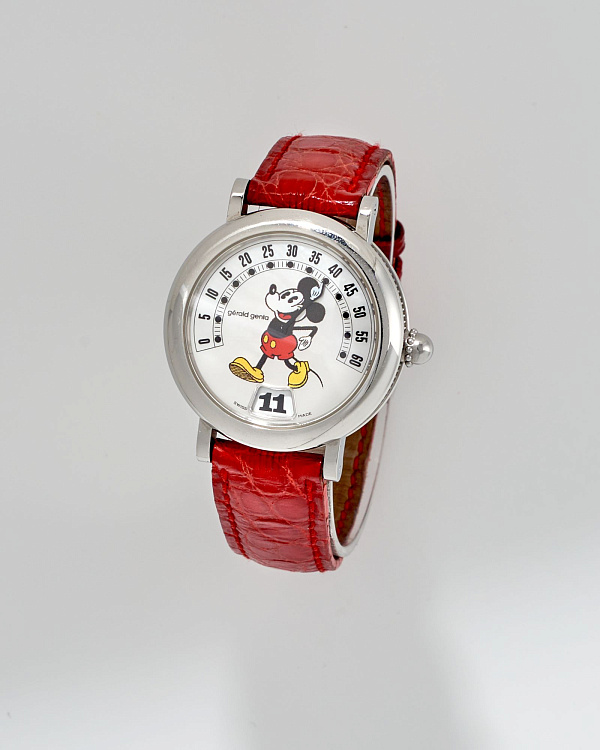
Produced around the same year, the Arena Contemporary Retro Classic Ref. REC.L.10 (Lot 01) is one of those with both the continuity of the master's style felt in the brand's collection after the move to Bulgari, as well as new features. These include a larger 38mm stainless steel case, extra-large minute numerals that form a wedge-shaped structure instead of a semicircle, and the signature Fabergé-style light blue guilloché dial. This clearly shows the influence of Bulgari design style.

In three Retro Classic watches – 36mm stainless steel Retro Classic Ref. G.3634 (Lot 05) with a blue dial, 36mm Retro Classic Ref. G.3632.7 (Lot 06) in yellow gold with a light cream guilloché dial, and in a similar design the 34mm Retro Classic Ref. G.3614.7 (Lot 07) we find classic examples of the style of the Retro collection, which in our opinion is not only not losing its relevance, but on the contrary is becoming more and more in demand.
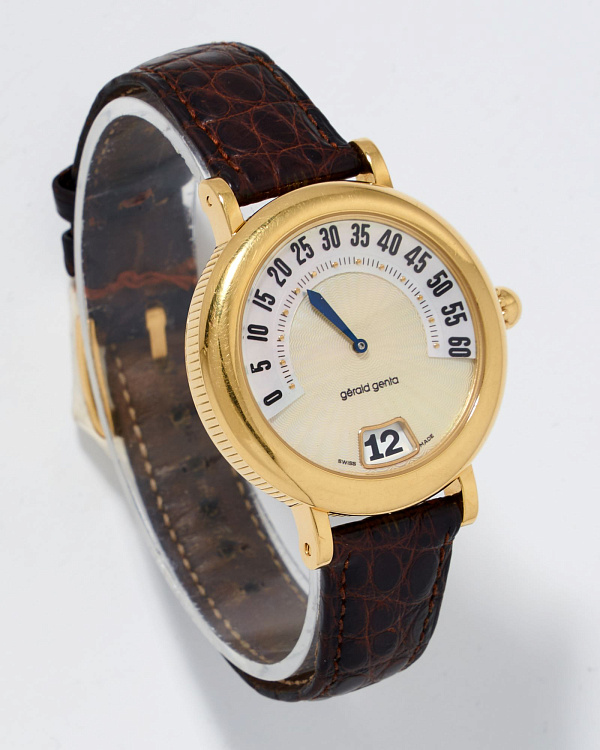
The more complex automatic caliber GA 4700 with double retrograde indication, developed by the brand in 1997, is the basis of the Biretro (originally Double Rétro) collection. The auction offers three models with the original version of this complication, which has a digital jumping hour at 12 o'clock, a 210-degree retrograde minute and a 150-degree retrograde date - the 38 mm Biretro Ref. G.3754 (Lot 03)in white gold, which was sold to the original owner in 2003, as well as the smaller 34 mm Biretro Ref. G.3714 (Lot 04) in yellow gold (this model is marked with the Retro Collection logo on the caseback) and the 38 mm stainless-steel Biretro Ref. BIR.L.10 (Lot 07) with steel bracelet.
Two other lots represent a fusion of the characteristic double retrograde display and style of the Gefica Safari bronze watch. This is the latest generation of Gefica Safari introduced by the brand in 2007: 46.5mm Biretro Gefica Safari Ref. GBS.Y.98.331.CN.BD (Lot 09) with a bronze and titanium case and a black and brown dial, and a rarer and therefore collectible 46.5mm model with a white silvered and brown dial Biretro Gefica Safari Ref. GBS.Y.98.330. CB.BD (Lot 10). These models are equipped with the caliber GG1004 developed shortly before, based on the Girard-Perregaux GP3100 automatic movement and featuring a new version of the double retrograde complication module. It has the 180-degree retrograde minute and date scales, as well as a central seconds hand, which was not present in the earlier version. In the Biretro Gefica Safari we see the influence of the big wristwatch trend of the early 2000s, while in the Gérald Genta collection of the classic period, when the brand belonged to Mr. Genta, we do not find big watches, even the most complex Grande Sonnerie was offered in a 39 mm case. Biretro Gefica Safari is the most spectacular manifestation of sporty-aggressive style of Gérald Genta and as such of interest to collectors and connoisseurs.
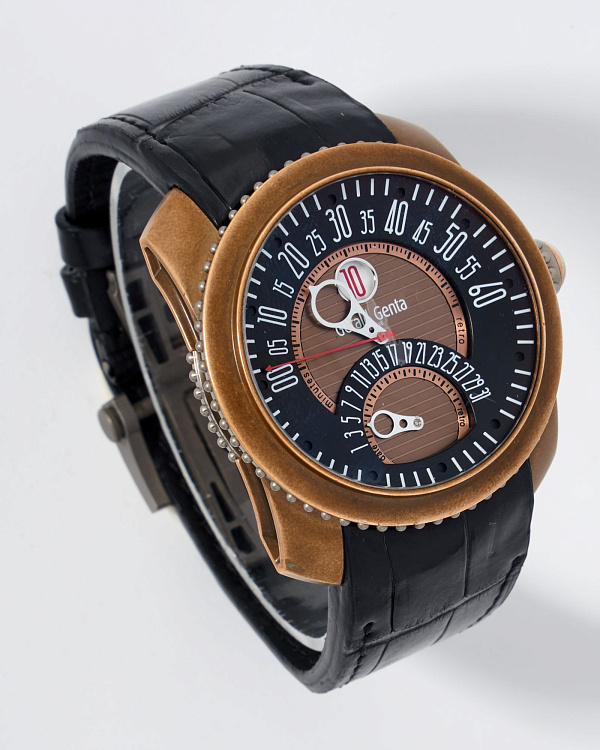
Gefica's original design meant that, in addition to bronze models, more classic versions with a precious metal case were launched. This design combines the hot temperament of the bronze Gefica Safari, originally designed for safari hunters, with the classic image of a moderate, thin and elegant watch. 33mm <Gefica Sahara Automatic Ref. G.3342.7 (Lot 15) the yellow gold version of the Gefica Safari, is certainly an interesting example of this style and shows how unpredictable Mr. Genta's creative path was.
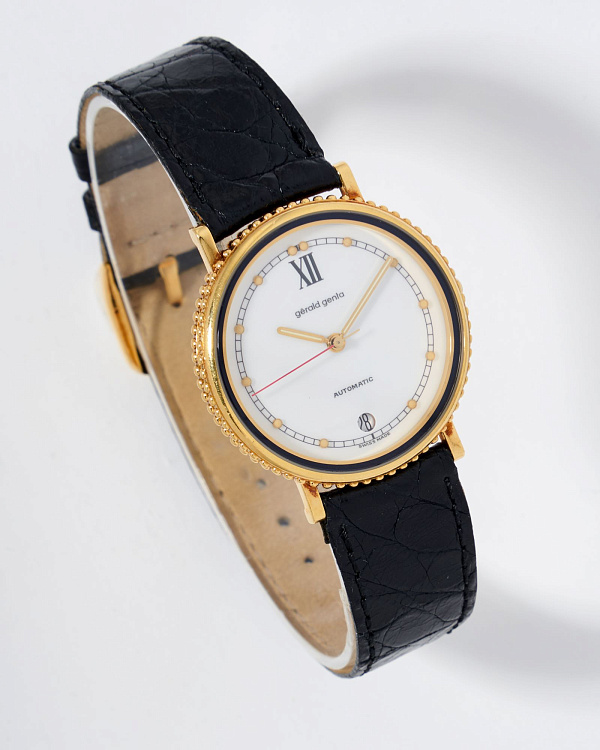
We recognize the octagonal design as the style most loved by Mr. Genta himself. He created many versions of this design, which, while not complete, is adequately represented in this auction. An attractive and highly unusual 35mm Octagonal GMT Chronograph Ref. G.3503.7 (Lot 11) in platinum with quartz movement features an octagonal trois-pommes case ring and bezel with 24-hour time zone markers and protruding side screws. The screw heads accentuate the baroque style and are located in the center of the sides rather than in the corners of the octagon. The refined design that gives this watch its unusual character is entirely in Mr. Genta's style.

34mm Octagonal Small Seconds Ref. G.3464.7 No. 25 (Lot 14) in yellow gold is a classic version of the Octagonal design. On this watch, probably made in the 1990s, we see signs of the new era, namely a sapphire caseback, which is unusual for watches from Gérald Genta's classic period in general. Thanks to this sapphire caseback, the watch owner has the opportunity to see the rare Frédéric Piguet Caliber 95, personalized by Gérald Genta. This caliber was developed by Frédéric Piguet in 1983, two years after Jean-Claude Biver became the owner of Blancpain together with Jacques Piguet, the owner of Frédéric Piguet. The ultra-thin 95 caliber (height of only 3.25 mm, which is outstanding for a center rotor caliber) was one of Frédéric Piguet's earliest developments. It was one of the most important developments that helped revive public interest in luxury mechanical watches. In the Octagonal Small Seconds, we find a version of this caliber with small seconds at the unusual 9 o'clock position - traditionally, such calibers are called Openface or Lépine. This watch is numbered 25, which in our opinion testifies to the rarity of this reference, so bidders have an excellent chance to acquire this rarity.
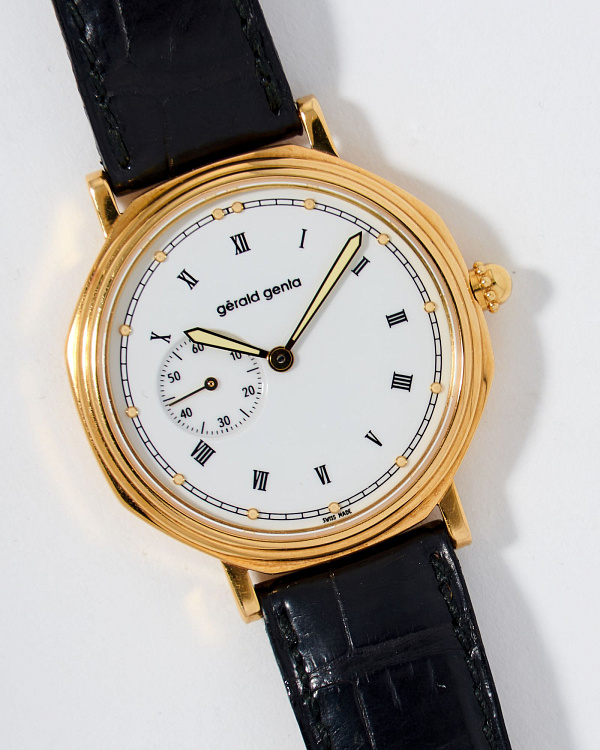
Mr. Genta often provided Octagonal models for complications, especially for calendars, for which the modules were developed by Pierre-Michel Golay. We find an automatic version of the complication with date, day of the week, moon phase and second time zone in the 32 mm Octagonal Day Date Moon Phase GMT Ref. G2747.4 (Lot 21) in yellow gold. As with almost all of Gérald Genta's moon phase watches, the design of this display is highly unusual and characteristic of Mr. Genta: the sub-dial is raised slightly above the level of the dial and consists of a gold rim with a beveled polished edge and a lapis lazuli disc set into it with a round aperture for moon. Incidentally, Mr. Genta was one of the few modern designers to use a round aperture for this complication, as was common in 17th century astronomical pocket watches, whereas we almost always see a fan-shaped aperture in modern wristwatches. 32 mm Octagonal Day-Date Moon Phase Ref. G2747.4 (Lot 24) in yellow gold is a simplified version of the previous watch, without a second time zone. Nevertheless, the previous reference number has been kept, which is generally atypical for the Gérald Genta collection of the classic period. In this regard, we have a guess, because both models differ only in the presence of a second time zone display, but are otherwise identical.
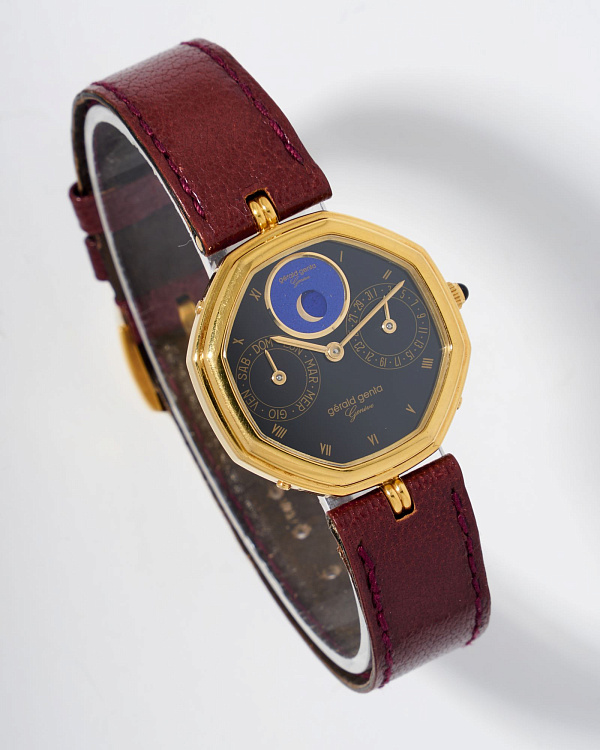
Gérald Genta is one of the few Swiss brands to have an in-house self-winding tourbillon movement, developed in the 1980s. One of the rare watches with this movement is the 36 mm Octagonal Tourbillon Automatic Ref. G4008.4 No. 39 (Lot 26) in yellow gold. The gilt caliber is hand engraved in floral rococo style and has a skeletonized and engraved oscillating weight with the GG logo. Also in the shape of a logo, but in a different style, is a steel tourbillon bridge that can be seen through the sapphire caseback. This rare early Octagonal Tourbillon Automatic is one of the most impressive lots offered in this auction.
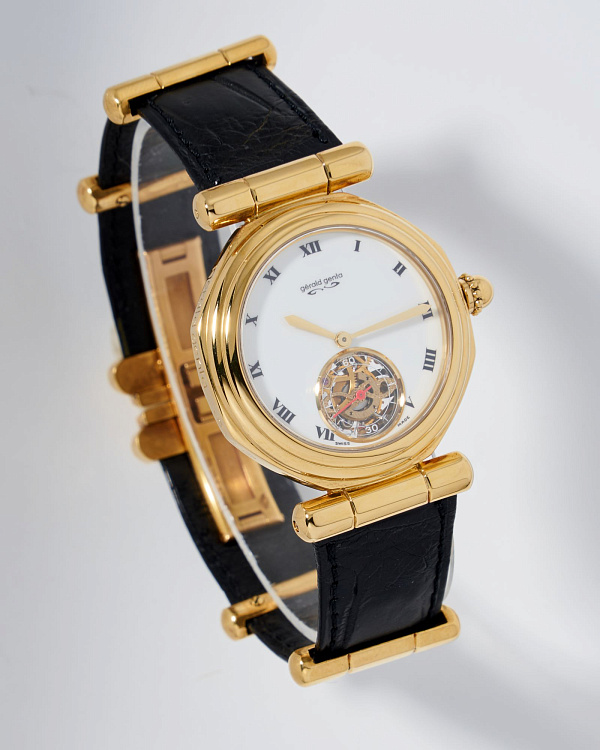
The Success (originally Spirit) collection, a sporty version of the Octagonal with the characteristic double bezel with the upper part of the spider shape, is presented in this auction in two models. The first is the 36mm Success (Spirit) Golf Ref. G.3513.7 (Lot 16) in stainless steel, which is one of Mr. Genta's golf-inspired designs. The watch with the image of the golf ball in the center of the dial is one of the most impressive and remarkable designs of all time on this subject. Watches from the Golf line are rarely auctioned, and each time it is a remarkable event. The second model in the Success collection, the 36mm Success (Spirit) Day Date Moon Phase GMT Ref. G.2983.7 (Lot 23) in stainless steel and yellow gold, is an extremely rare version of the reference G.2983 with Clous de Paris motif on the dial.
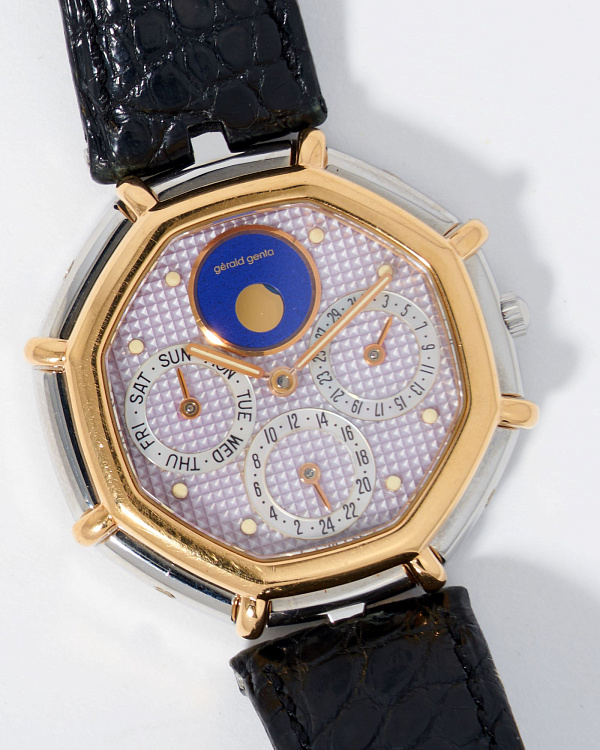
An unusual version of the Octagonal design is found in the automatic Octagonal Triple Calendar Moon Phase Ref. G.1988 for Van Cleef & Arpels (Lot 20) The octagonal case of this watch has longer horizontal and vertical (even) sides and short oblique (odd) sides. The navy blue dial of the watch has an irregular texture that perfectly matches the lapis lazuli moonphase sub-dial, a regular option for moonphase watches by Gérald Genta. This model seems to be one of the most complex and rare ones offered by Gérald Genta for Van Cleef & Arpels, which adds to the appeal of this lot. Another version of the octagonal design is offered by the Lady Quartz Ref. G.3181 (Lot 18), a yellow gold ladies' watch with a diamond-set bezel and a yellow gold jewelry bracelet also set with diamonds.
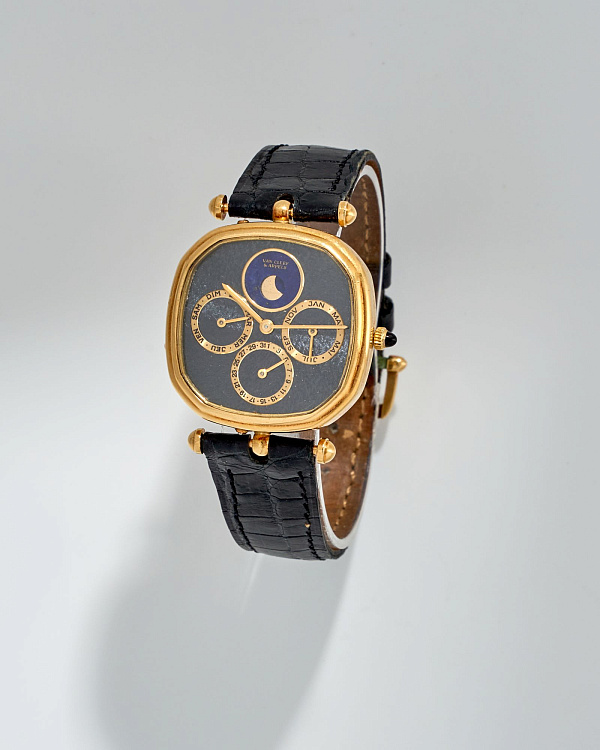
We conclude our review with Gérald Genta's round watches, which came in a variety of designs - from simple “solo tempo” models with two hands to watches with one or more complications.
Of the two-hand type, there is a highly unusual and very rare for Gérald Genta skeletonized in the classic rococo style 34mm two-tone yellow gold and white gold Two-Gold ‘Harlequin’ Skeleton Ref. G.1610 (Lot 19) watch. It uses the superb ultra-thin (2.4 mm thick) Frédéric Piguet 71 self-winding movement in a skeletonized version with its characteristic slightly off-centered rotor. Apart from the fact that watches of this type appear extremely rarely on the market, they have another interesting feature that we found in all skeletonized Gérald Genta "Solo Tempo" models that we found. It seems that for thin skeletonized two-hand watches, Mr. Genta liked to use a two-tone design of yellow and white gold. For this watch, he decided to split the round, fully engraved case into four parts in two shades of gold, creating the 'Harlequin' design. We are sure that the discerning collector will pay attention to this watch.
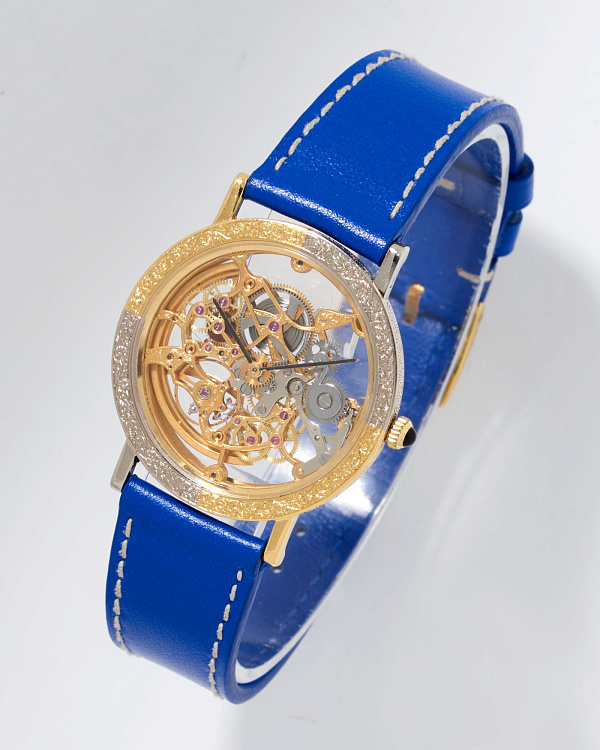
The slim and elegant self-winding yellow gold Classic Ref. G.3132.7 (Lot 12) watch with three hands and date window has a polished "double pomme" bezel and a beautifully textured black dial, which allows us to call this model a dress watch. A similar 36 mm Classic Ref. G.3132.7 (Lot 13) offers a different combination - white gold and a light cream dial. 35 mm Classic Dual Time Ref. G3257 (Lot 17) in yellow gold is equipped with an Eta caliber 2892 with automatic winding and features a second time zone module with a GMT sub-dial with hour and minute hands at 6 o'clock and an additional crown to control this function. This model is particularly striking for its Empire style with a slightly recessed case ring and large screws with polished hemispherical heads on the lugs, and is equipped with a distinctive two-tier dial in translucent white material with printed blue markings.
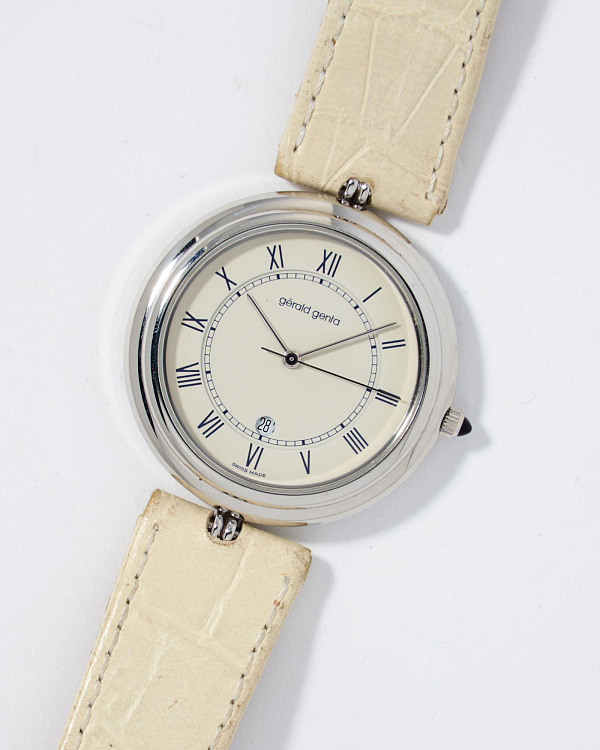
36 mm <Perpetual Calendar Moon Phase Automatic Ref. G.2132.4 (Lot 22) in yellow gold with the classic polished "double pomme" bezel is equipped with a self-winding perpetual calendar movement designed by Pierre-Michel Golay. The base of the movement is an ultra-thin Frédéric Piguet 71, which undoubtedly increases the collector value of this lot. It features a unique counter layout and the signature moonphase design with a lapis lazuli sub-dial and a round aperture for a moon. Gérald Genta launched this model in 1977. Thus, the watch belongs to the exclusive circle of the earliest automatic wristwatches with perpetual calendar.
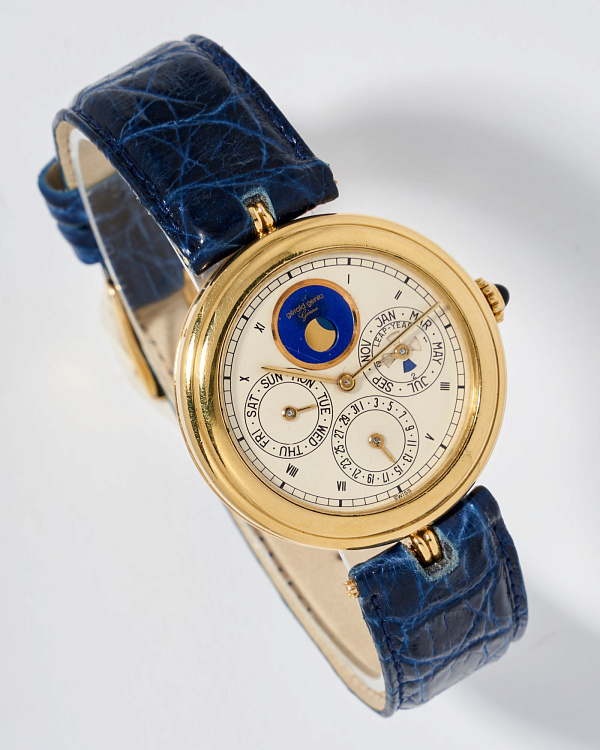
The undisputed leader of The Legacy of Gérald Genta auction is the 36mm Minute Repeater Perpetual Calendar Moon Phase Automatic Ref. G2015.4 No. 74 (Lot 25). This magnificent watch is equipped with an in-house movement consisting of an automatic minute repeater caliber and a perpetual calendar module, both developed by Pierre-Michel Golay. Despite the high complexity, the watch has a very modest size of 36 mm, which evokes respect for the craftsmanship of the brand, which is able to build very compact and thin ultra-complex calibers. Instead of the classic sliding lever, this watch is equipped with a start button for the repetition - another innovative development of Gérald Genta, which made it possible to offer waterproof repetition watches. The design of the watch is calm and classic, with a matte white dial with small Roman numerals in the style of Mr. Genta, moonphase display with a lapis lazuli sub-dial and a round moon aperture. The back of the watch with its sapphire caseback reveals a magnificent rare caliber with skeletonized rotor, gilded mainplate and bridges generously engraved by hand with rococo style floral motifs. A watch that invites you to enjoy the wonderful sounds of gong chimes, perhaps tuned by Pierre-Michel Golay himself, who has perfect pitch and boasts a career as an opera singer at the Grand Théâtre de Genève, is a true masterpiece of haute horlogerie that can be the centerpiece of a precious watch collection.